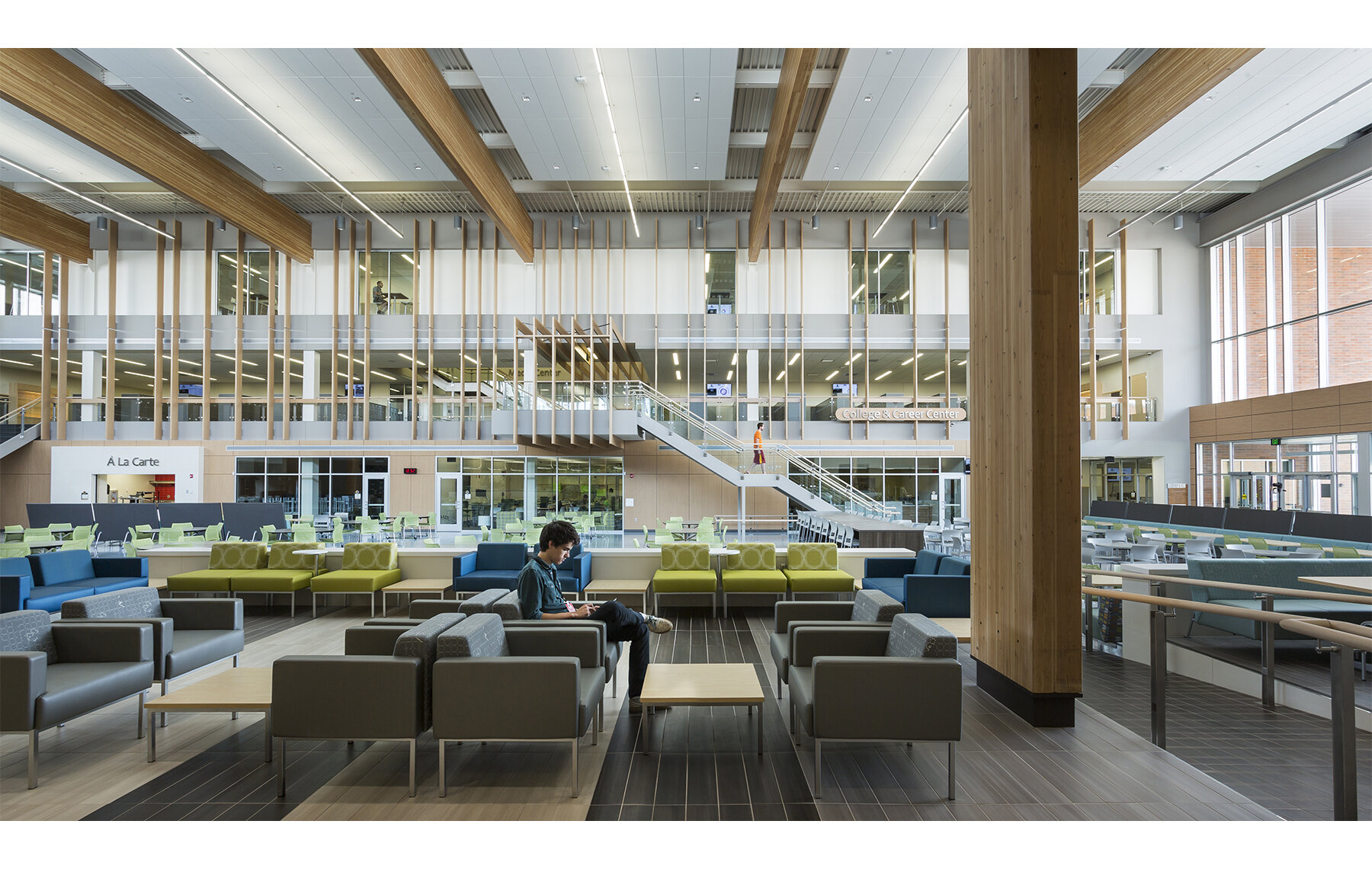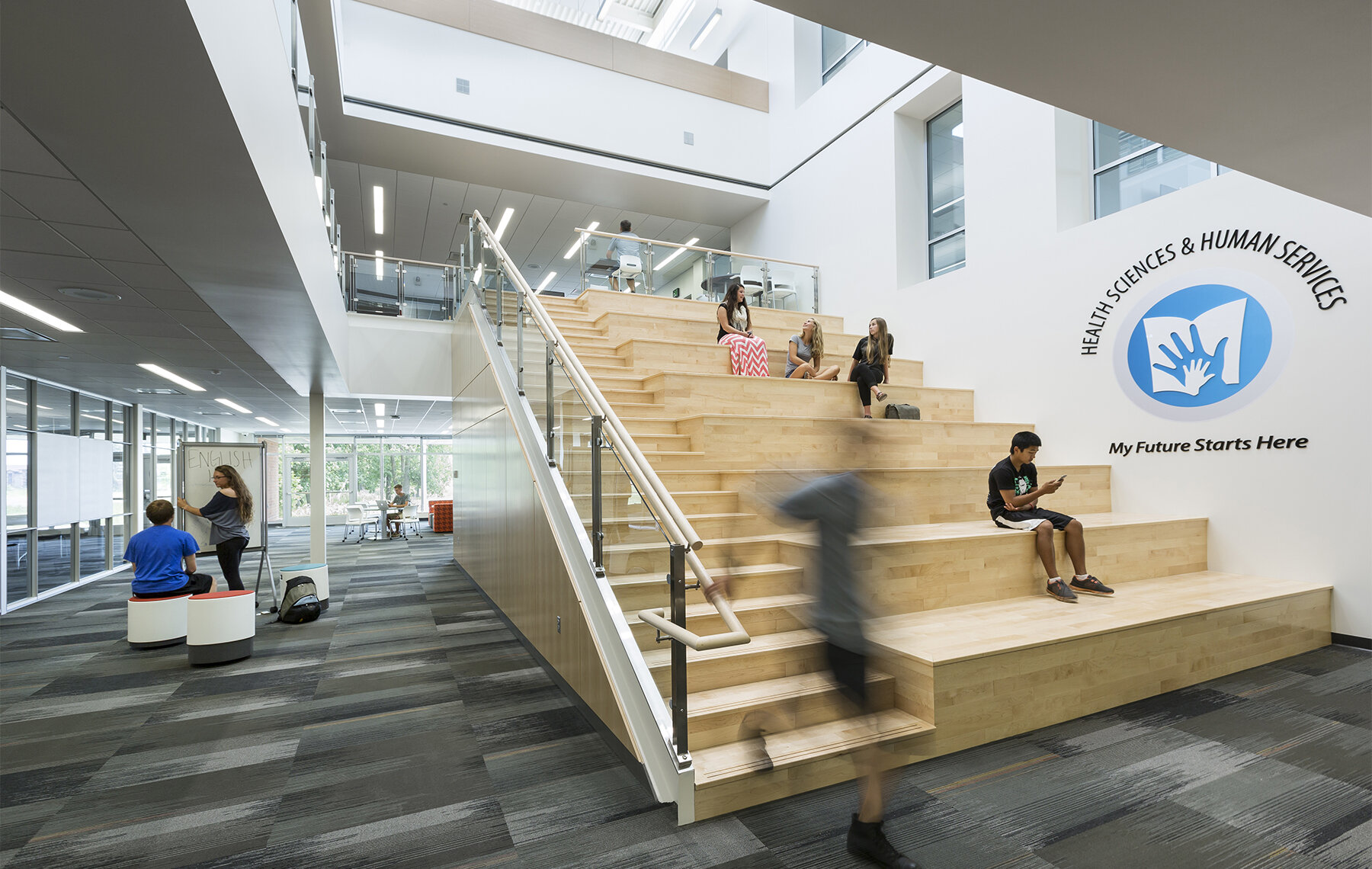Post-Pandemic Education
In the final installment of a three-part series on the effects of the pandemic on how Minnesotans live, work, shop, and learn, the director of the Minnesota Design Center highlights a growing opportunity in education: hybrids of in-person and online learning
By Thomas Fisher, Assoc. AIA | July 22, 2021
Flexible, comfortable learning spaces at Alexandria Area High School in Alexandria, Minnesota. Design by Cuningham Group Architecture, with associate architect JLG Architects. Photo by Gaffer Photography.
FEATURE
The COVID-19 pandemic has had a transformative impact on education. In the U.S., over 56 million schoolchildren (globally, over 1.2 billion) switched to online learning during the shutdown, as did about 18 million U.S. college students. Students began to return to classes this past spring, and most likely will be back in the fall, but the residual effects of last year’s remote-learning immersion will remain, as the pandemic accelerated educational trends well underway. Prior to the pandemic, learning technology had already become a nearly $19 billion industry; now, it’s projected to reach $350 billion by 2025, with many schools investing heavily in “EdTech,” ranging from language apps to online tutorials.
EdTech’s benefits to students, however, remain mixed. The speed with which schools went online during the pandemic meant that about 25 percent of U.S. students, many in lower-income families or in remote areas, lacked the technology and bandwidth to access their classrooms and coursework. With over 30 million Americans having limited or no Internet connection, the Biden Administration has proposed $100 billion in its infrastructure plan to provide high-speed connectivity to every U.S. household.
At the same time, research has shown that e-learning helps students retain course content from three to six times more than when learning in person, and absorb five times more content in the same amount of time. While most teachers and students look forward to their return to the physical classroom, various hybrids of online and in-person education seem inevitable, given their complementary strengths and weaknesses.
Hybrid higher education can offer people lower-cost, life-long learning from wherever they live, while also helping higher-ed institutions leverage their knowledge more fully and efficiently, across a much broader age range.
Hybrid models will inevitably affect what happens in classrooms. The Just Ask Us movement has begun to explore those impacts by listening to the diverse voices of those who have the most at stake in attaining a quality education: students and their parents. Implementing their ideas will require a more innovative mindset within the educational system, one that’s open to the kinds of experiments students, parents, and teachers want to explore, while accepting, as a recent Brookings Institution report says, an iterative approach: evaluating, course-correcting, and scaling up what works best.
Educational facilities will invariably change as well. The old industrial model of standard classrooms down long corridors seems ill suited to a 21st-century educational system in which creativity has become a core educational goal. In a recent article on post-pandemic school design, architect Prakash Nair, AIA, talks about schools becoming learning communities, replacing classrooms and corridors with learning studios, teacher collaboration spaces, areas for wet or messy work, and a media bar where students can access information when needed.
Alexandria Area High School was designed as a learning village with a soaring community commons at its center, a variety of learning and social settings, and ample natural light throughout the 285,000-square-foot building. Photos by Gaffer Photography.
The post-pandemic changes coming to higher education may be even more dramatic. Colleges and universities, too, have plenty of classrooms and lecture halls that stand increasingly empty as faculty have “flipped” their courses and as students have demanded more student-centered ways of learning. Prior to the pandemic, I taught a class nomadically, letting my students choose where they wanted to meet, and not once did they select a classroom or lecture hall. Instead, they preferred places that had comfortable furniture, ample daylight, and interesting views. After a year spent teaching and learning at home, faculty and students may well seek some of the same comforts on campus.
The digital platforms that became the dominant way of delivering education this past year raise further questions about the nature of higher education. Colleges might ask: Who are our students when the Zoom platform allows up to 300 participants, of any age or at any location, to audit a class or hear a lecture? Who are our faculty when experts from around the world can log on to a class to teach and interact with students? And why have our campus when professors and students can teach and learn from almost anywhere in the world?
Such questions do not intend to devalue on-campus learning by traditional-aged students taught by resident faculty. But they do suggest that colleges and universities have opportunities to make higher education more accessible, affordable, and equitable than ever before. Hybrid higher education can offer people lower-cost, life-long learning from wherever they live, while also helping higher-ed institutions leverage their knowledge more fully and efficiently, across a much broader age range. In the wake of COVID-19, learning has the potential to become pervasive, in what Arizona State University president Michael Crow calls the “fifth wave” in higher education, where equity and excellence are complementary.
The design community has a role to play here, too. Education itself has become a design challenge that could benefit from the empathetic listening, problem reframing, creative ideation, rapid prototyping, and critical evaluation that design thinking offers. Designers need to look beyond reimagining educational facilities to become facilitators of a design process in partnership with educators and students. One of the great lessons of the pandemic may be that we all have much to learn.
The articles in this series (see below) by Thomas Fisher, Assoc. AIA, a professor in the School of Architecture and director of the Minnesota Design Center (MDC) at the University of Minnesota, are based on research the MDC has done this past year on pandemic impacts on how Minnesotans live, work, shop, and learn. Funded by the McKnight Foundation, the research has been the focus of a series of community workshops, a Grand Challenge course, a U College of Design webinar series, a pandemic-year blog, and a podcast series. Fisher is also writing a book on this subject, which Routledge will publish in 2022. This work continues the 35-year history of the MDC, which is dedicated to improving the built environment and the systems that shape that environment in Minnesota and the Upper Midwest through the use of design as an empathetic, creative, and community-based process.






